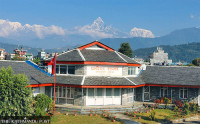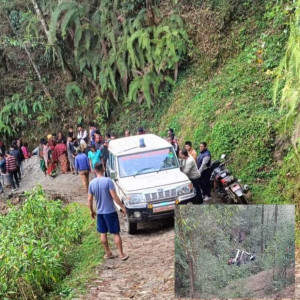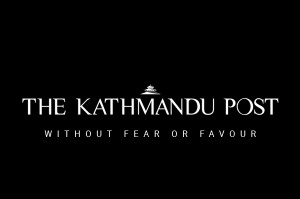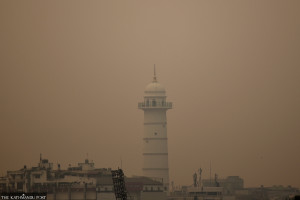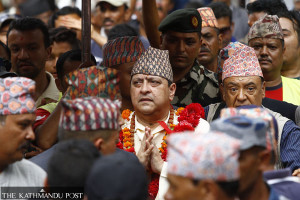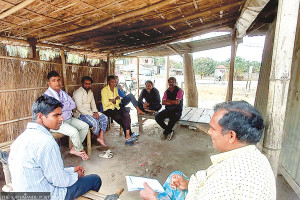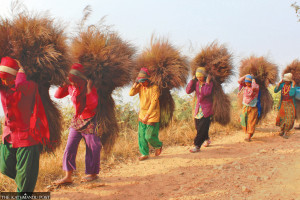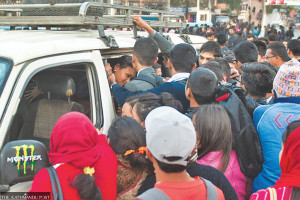 30.12°C Kathmandu
30.12°C KathmanduBagmati Province
In Makwanpur, Chepang households turn to beekeeping but see little returns
Without a direct farm-to-market connection and government support, most bee farmers remain at the mercy of traders
Samuel Chhetri
Every day, Yusai Praja wakes up at the crack of dawn and starts preparing a sugar syrup called chasni to feed his bees. It’s early spring and there are not enough flowers for the bees; yet, they must be fed.
In this Chepang community in Raksirang, Makwanpur, most families begin their day like Yusai. Like other Chepang families in the village, Praja took up honey farming as the remote Pamtung village of Raksirang is mostly rugged terrain, with few plots of arable land. Profits, however, haven’t been as expected; in fact, most households are barely making enough to sustain their livelihoods.
Yusai began farming honey in 2013, with a purchase of around 65 beehives. He invested in the western honey bee, Apis mellifera, which is prized for its high honey yield. The start-up cost for each beehouse was around Rs 10,000 with the queen bee, and Rs 5,000 without. But in the years since, he’s barely made enough to recover his yearly investments.
Each beehive yields around 20 kg of honey in the harvest season, which amounts to about Rs 240,000. But much of this income goes right back into the bees.
“When the blossom season is over, each farmer has to buy sacks of sugar worth over Rs 250,000-Rs 300,000 per year for sugar syrup for the bees, and spend another Rs 100,000 on the treatment of the bees,” said Yusai.
Bees can also be unpredictable—this year, only 40 out of Yusai’s 65 beehives produced honey.
According to Yusai, in an ideal situation with favourable conditions, a farmer with over 80 to 100 beehives can make around Rs 700,000 to Rs 800,000 gross in one season (mid-October to January), but this amount remains unachievable for most Chepang farmers in Raksirang.
Moreover, stationing their beehives in another farmer’s plot of mustard or buckwheat costs around Rs 25,000 per month in rent, or a cut of the beekeepers’ honey.
“The alternative is to feed the bees sugar syrup or move them to a denser flora area,” said Yusai. “Some farmers from Raksirang haul their bee colonies to Chitwan, which is an expensive trip full of uncertainties for the bees.”
Recognised as one of the 59 indigenous nationalities in the country, the Chepang community, living mostly on the hilly and steeper slopes of the Mahabharat and Chure range, is spread out across Makawanpur, Chitwan, Dhading, Gorkha, Lamjung and Tanahu districts, and is considered highly marginalised. Most Chepangs are uneducated and even to this day, live in segregated communities, hunting, foraging and fishing for a living. For many Chepang families, raising bees is halfway between their traditional ways of life and modern pressures.
But without adequate incomes, some Chepang farmers are taking loans to fund their honey farming. Surya Bahadur Praja, who is also from Raksirang, has only 25 beehives and his income is around Rs 150,000 per season. After buying sugar for his bees and putting aside some funds for their treatment, Surya is left with few choices but to take out loans to support his family of seven.
“Some of us have outstanding loans on our heads and with a 5-10 member family on average, whatever is left is spent before the start of the next honey harvest season,” said Surya. The money left over from his seasonal earnings is hardly enough to cover the tuition fees of his three children.
Most Chepang farmers blame the lack of proper farm-to-market connection and the irregular pricing of local honey for the lack of a sufficient income from beekeeping.
“Retailers in big cities make massive profits off our backs,” said Yusai. “It’s not that they should not make a profit but there should be market regulations and fair pricing that will not only benefit them but also farmers like us.”
The honey extracted by farmers is collected through various cooperatives set up to open market access for honey farmers.
“We usually get Rs 300-Rs 400 per kilogram of chiuri honey,” said Yusai. “Some farmers who have hives of local giant honey bees (Apis dorsata) and eastern honey bees (Apis cerana) sell their honey for Rs 800-Rs 900 per kilogram.”
Honey from local wild bees, which is the most sought-after honey, is negligible in terms of quantity as changing weather patterns, the growing use of pesticide in farms, and increasing proliferation of western honey bees, which sometimes interfere with migratory patterns, have affected the population of local species, said Yusai.
Various honey retailers, on the other hand, believe that this is a good time to be a honey farmer.
“Honey farming has great potential for profit,” said Mahalaxmi Shrestha of The Beekeeping Shop, a store that retails bee products. “Many farmers involved in this business have seen their livelihoods get better.” Farmers have been earning good money and have been able to take up the profession as a sustainable means of making a living, she said.
But Dinesh Chepang, a member of the Kankada-based Shree Janachetana Sana Kisan Krishi Sahakari Sanstha Limited and proprietor of Silunge Mauripalan Udhyog, who also collects honey from Raksirang farmers, said that farmers have not been able to reap benefits as they often do not get paid adequately or on time.
“There is no guarantee that the buyers who bought honey from them earlier will come back to buy from them again next season,” he said.
A way out, according to Dinesh, is for government authorities to certify the honey produced by the Chepang community as organic, which can boost sales.
“The authorities should take the initiative to encourage honey farmers to use organic methods while rearing bees,” he said. “The production of certified organic honey will give farmers an upper hand and they can set a proper price for their products.”
In order to get certified as organic, farmers must refrain from using fertilisers on their mustard and buckwheat farms, avoid transporting their beehives to Chitwan, and use traditional methods, not chemicals, while treating sick bees.
“Our demand for organic certification fell on deaf ears at the Beekeeping Development Office and without their assistance, we will not be able to sell our products with the organic tag,” said Dinesh.
Baidyanath Purbe, information officer at the Bhandara, Chitwan-based Beekeeping Development Office, said that the process of granting an organic certificate to honey produced in Nepal is a tedious process. If the process is to be carried out as per the books, a farmer will have to get every batch of their honey tested, he said. And the Department of Food Technology and Quality Control in Babarmahal, Kathmandu is the only unit in the country where such tests can be conducted.
“It is impossible to get a fair price unless there is certification and for certification, we need more testing laboratories and a hassle-free process of certification,” said Purbe. “As the situation stands, farmers are forced to sell their honey at whatever price they are offered by traders—after all, they have to feed their bees once the blooming season is over.”
According to Thakur Prasad Dawadee, Programme Coordinator at the Federation of Beekeeping Nepal, the government has come up with provisions to streamline the beekeeping and honey-making business. However, this government policy on bees, endorsed on January 10, 2017, has been limited to paper and hasn’t been implemented yet.
“Lacking proper implementation policies, Nepali honey is on the verge of being trumped by imported honey, as the latter is readily available in the market at almost half the price of Nepali honey,” said Dawadee. “The government must work to implement policies that would benefit honey farmers and the overall industry.”
Apart from some local government bodies providing subsidies to honey farmers to buy beehives, there is no other state assistance.
Beekeepers like Yusai and Surya have explored new methods for better yield, like planting Indian butter trees, locally known as chiuri, for the bees to feed on. Honeybees are known to be especially attracted to the chiuri flower, which secretes large amounts of sweet nectar when they bloom in mid-November to mid-January.
The bees, however, are already at work before the chiuri blooms, feeding on mustard flowers that are abundant. Farmers, however, do not prefer mustard flower honey as it tends to turn semi-solid and has a limited shelf life, gradually losing its dark golden colour.
And so, honey farmers, especially from the Chepang community, remain at the mercy of traders and retailers.
“The ground reality is that the retail end of the honey business is earning handsomely while there has been almost no change when it comes to uplifting our livelihoods,” said Yusai. “The little we make is not enough to sustain our lives, let alone that of our bees.”







